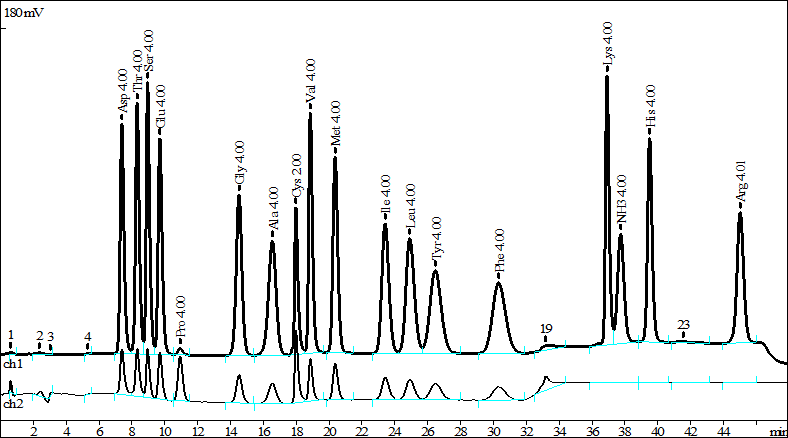STUDY OF THE PEGANUM HARMALA AMINO ACID COMPOSITION GROWING IN AZERBAIJAN
UDC 615.322
Abstract
The aim of the research is a qualitative and quantitative study of the amino acid composition of Syrian rue (Peganum harmala, Nitrariaceae), growing in the natural conditions of the Azerbaijan Republic. After preliminary confirmation of the presence of amino acids, the plant parts were subjected to in-depth study by ion-exchange chromatography using post-column derivatization on a L-8800 amino acid analyzer (Hitachi, Ltd.). Amino acid analysis of the roots of P. harmala, conducted in the course of this study, was carried out by us for the first time. According to the results of the analysis, 18 amino acids were identified in the studied parts of P.harmala, 8 of which nonessential, 9 are essential and 3 are conditionally essential. The total amount of amino acids for the roots was 7.162%, seeds - 6.096%, and stems - 14.676%. From the individual amino acids in the underground organs of P. harmala, proline predominates (2.149%), and aspartic acid predominates in the stems and seeds (2.698% and 2.394%, respectively). The least detected amino acids are ornithine in the roots and stems (0.007% and 0.020%, respectively) and cysteine in the seeds (0.024%). Hydroxyproline was not found in the stems. At the same time, with the exception of proline, hydroxyproline, hydroxylysine and ornithine in the stems, the remaining amino acids were found to be higher than in other organs.
Downloads
Metrics
References
Xi Z., Pengyuan Z., Fei G., Yijun Z. Mitochondrial DNA Part B Resources, 2020, vol. 5, no. 1, pp. 652–653. DOI: 10.1080/23802359.2019.1711230.
Apostolico I., Aliberti L., Caputo L., De Feo V., Fratianni F., Nazzaro F., Souza L.F., Khadhr M. Molecules, 2016, vol. 21, no. 9, p. 1235. DOI: 10.3390/molecules21091235.
Shatarat A.T., Abuhamdah S., Alefishat E., Al-Essa M.K., Rima R.A., Mohammed F., Badran D., Jafar H. Pharma-cognosy Journal, 2020, vol. 12, no. 2, pp. 260–265. DOI: 10.5530/pj.2020.12.40.
Hajji A., Vitales D., Elgazzeh M., Garnatje T., Valles J. Turkish Journal of Botany, 2017, vol. 41, pp. 324–328. DOI: 10.3906/bot-1609-24.
Sheahan M.C., Chase M.W. Bot. J. Linn. Soc., 1966, vol. 122, no. 4, pp. 279–300. DOI: 10.1111/j.1095-8339.1996.tb02077.x.
Mutasher H.H., Attiya H.J. Iraqi Journal of Science, 2019, vol. 60, no. 7, pp. 1442–1451.
Ayoob I., Hazari Y.M., Lone S.H., Shakeel-u-Rehman, Khuroo M.A., Fazili K.M., Bhat K.A. Chemistry Select, 2017, vol. 2, p. 2965. DOI: 10.1002/slct.201700232.
Khan F.A., Maalik A., Iqbal Z., Malik I. European Journal of Pharmacology, 2013, vol. 721, no. 1–3, pp. 391–394. DOI: 10.1016/j.ejphar.2013.05.003.
Lewerenz L., Hijazin T., Abouzeid S., Hänsch R., Selmar D. Phytochemistry, 2020, vol. 174, 112362. DOI: 10.1016/j.phytochem.2020.112362.
Herraiz T., Guillén H., Arán V.J., Salgado A. Food and Chemical Toxicology, 2017, vol. 103, pp. 261–269. DOI: 10.1016/j.fct.2017.03.010.
Li S.G., Wang K.B., Gong C., Bao Y., Qin N.B., Li D.H., Hua H.M. Bioorganic & Medicinal Chemistry Letters, 2018, vol. 28, no. 2, pp. 103–106. DOI: 10.1016/j.bmcl.2017.12.003.
Shaheen H.A., Issa M.Y. Scientia Horticulturae, 2020, vol. 264, 108940.
Niaz A., Ullah N., Rehman A, Ahmad I., Ikhlaq M., Rehman U.H. International Journal of Pharma Sciences and Re-search (IJPSR), 2013, vol. 4, no. 2, pp. 17–24.
Soliman M.S., El-Ansary A. Journal of Applied Sciences, 2007, vol. 19, pp. 2881–2885.
Zhang Z., Mao C., Shi Z., Kou X. Front. Plant Sci., 2017, vol. 8, p. 1231. DOI: 10.3389/fpls.2017.01231.
Biancarosa I., Espe M., Bruckner C.G., Heesch S., Liland N., Waagbo R., Lock E.J. Journal of Applied Phycology, 2017, vol. 29, pp. 1001–1009. DOI: 10.1007/s10811-016-0984-3.
Maeda H., Dudareva N. Annu. Rev. Plant Biol., 2012, vol. 63, pp. 73–105. DOI: 10.1146/annurev-arplant-042811-105439.
Rai V.K. Biologia Plantarum, 2002, vol. 45, no. 4, pp. 481–487. DOI: 10.1023/A:1022308229759.
Berezov T.T., Korovkin B.F. Biologicheskaya khimiya. [Biological chemistry]. Moscow, 1998, 704 p. (in Russ.).
Li P., Mai K., Trushenski J., Wu G. Amino Acids, 2009, vol. 37, no. 1, pp. 43–53. DOI: 10.1007/s00726-008-0171-1.

Copyright (c) 2021 chemistry of plant raw material

This work is licensed under a Creative Commons Attribution 4.0 International License.

This work is licensed under a Creative Commons Attribution 4.0 International License.
The authors, which are published in this journal, agree to the following conditions:
1. Authors retain the copyright to the work and transfer to the journal the right of the first publication along with the work, at the same time licensing it under the terms of the Creative Commons Attribution License, which allows others to distribute this work with the obligatory indication of the authorship of this work and a link to the original publication in this journal .
2. The authors retain the right to enter into separate, additional contractual agreements for the non-exclusive distribution of the version of the work published by this journal (for example, to place it in the university depository or to publish it in a book), with reference to the original publication in this journal.
3. Authors are allowed to post their work on the Internet (for example, in a university repository or on their personal website) before and during the review process of this journal, as this may lead to a productive discussion, as well as more links to this published work.











